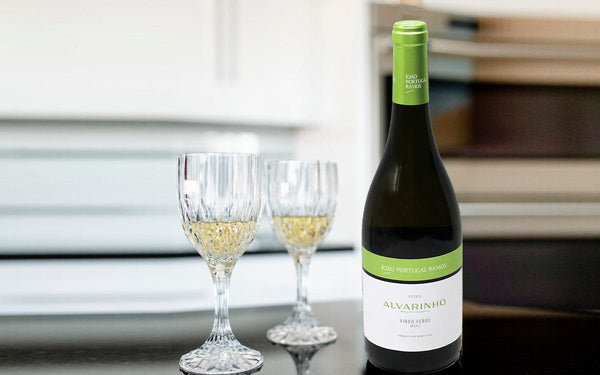Exploring the Delights of Vinho Verde: A Guide to Portugal's Crisp and Refreshing Wine

One style of Portuguese wine embodies the essence of a sunny day by the coast: Vinho Verde. Literally translating to "green wine," this refreshing and vivacious wine is a delightful discovery for both the seasoned wine enthusiast and the casual sipper. In this guide, we'll embark on a journey through the world of Vinho Verde, from its history and winemaking techniques to its unique characteristics and food pairings.
A Brief History of Vinho Verde
Vinho Verde has a rich history that dates back centuries. This wine hails from the verdant region in the northwest of Portugal, which is characterized by lush landscapes, rolling hills, and proximity to the Atlantic Ocean. It is in this idyllic setting that Vinho Verde grapes have been cultivated for generations.
Historically, Vinho Verde was known for its slight effervescence, which occurred naturally during fermentation due to the region's cool climate. This effervescence added a lively quality to the wine, making it a popular choice for refreshment.
Grapes That Paint the Green Landscape
The key to Vinho Verde's distinctive flavor lies in the choice of grape varieties. While there are numerous indigenous grapes used in the production of Vinho Verde, a few stand out as the stars of the show:
- Alvarinho: Known as Albariño in neighboring Spain, Alvarinho grapes bring a zesty and citrusy character to Vinho Verde. Their high acidity and aromatic qualities make them a prized component in many blends.
- Loureiro: Loureiro grapes contribute delicate floral and herbal notes, adding complexity and finesse to the wine. Their aromatic profile makes them an essential grape in Vinho Verde production.
- Arinto: Arinto grapes bring bright acidity and a refreshing lemony zest to the wine. They provide structure and balance to the blends, ensuring a harmonious taste.
- Trajadura: Trajadura grapes add a subtle floral aroma and a touch of minerality to Vinho Verde. They are often used to round out the blends and enhance the overall character.
- Avesso: Avesso is prized for its full-bodied nature and a creamy texture that balances the acidity of other grapes. It contributes a unique richness to the wine.
Winemaking Techniques: The Sparkling Secret
Traditionally, Vinho Verde was known for its slight effervescence, which was a result of the wine being bottled before fermentation was complete. While this natural fizz has become less common, it's still possible to find lightly sparkling Vinho Verde labeled as "Loureiro" or "Espumante." These wines offer a playful and effervescent wine tasting experience.
Most Vinho Verde wines today are produced in a still, non-sparkling style that you will enjoy when you order wine delivery. They are typically unoaked, allowing the pure expression of the grapes and the terroir to shine through. The winemaking process often involves temperature-controlled fermentation to preserve the wine's vibrant aromatics and freshness.
The Quintessential Vinho Verde Experience
What sets Vinho Verde apart from other wines is its signature profile of crisp acidity, low alcohol content (usually around 9-11%), and a burst of citrus and green apple flavors. These qualities make it the perfect choice for warm-weather sipping and pairing with a variety of dishes.
Pairing Vinho Verde
One of the joys of Vinho Verde is its versatility when it comes to food pairings. Its lively acidity and refreshing character make it an excellent match for a wide range of dishes, including:
Seafood: Vinho Verde's maritime influence and crisp acidity make it a superb companion for seafood. Try it with grilled shrimp, oysters, or ceviche.
Salads: The wine's green apple and citrus notes harmonize beautifully with fresh salads, especially those featuring vinaigrette dressings.
Asian Cuisine: Vinho Verde's acidity can cut through the bold flavors of Asian dishes, making it a great choice for sushi, Thai curries, and Vietnamese spring rolls.
Lighter Fare: It's equally delightful with light pasta dishes, vegetarian fare, and even as an aperitif to whet your appetite.
Exploring Vinho Verde Styles
While Vinho Verde is known for its white wines, there are a few other styles worth exploring:
Red Vinho Verde: Made from red grape varieties like Vinhão and Padeiro, these red wine bottles offer a unique experience with notes of red fruit, spice, and a hint of fizz.
Rosé Vinho Verde: Combining the freshness of Vinho Verde with the charm of rosé, these wines are crisp, fruity, and perfect for summer sipping.
Aged Vinho Verde: Some producers offer aged Vinho Verde, which develops more complex flavors and a richer texture over time.
Exploring the Vinho Verde Region
If you're ever fortunate enough to visit Portugal, a trip to the Vinho Verde region is a must. Here, you can explore picturesque vineyards, enjoy wine tastings at local estates, and immerse yourself in the culture of this vibrant wine-producing region. The Vinho Verde Wine Route (Rota dos Vinhos Verdes) offers a fantastic way to discover the beauty and flavors of this enchanting area.
In all, Vinho Verde is more than a wine; it's an experience culminated when you order wine online. Its lively character, refreshing qualities, and versatility make it a beloved choice for wine enthusiasts worldwide. Whether you're picnicking on a sunny day, savoring seafood by the sea, or simply seeking a delightful sip of Portugal's coastal charm, Vinho Verde is ready to refresh your palate and transport you to the lush landscapes of northwest Portugal. Cheers to Vinho Verde, where every bottle tells a story of tradition, terroir, and the joy of life's simple pleasures.


















Leave a comment